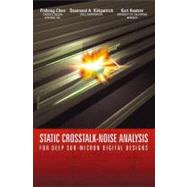
What is included with this book?
| List of Figures | |
| List of Tables | |
| Preface1 | |
| Introduction | |
| Motivation | |
| Process Trends | |
| CMOS Circuitry | |
| Background and Crosstalk Effects | |
| Static Timing Analysis | |
| Crosstalk Effects | |
| Functional Failure | |
| Timing Variation | |
| Search Space Pruning | |
| Spatial Pruning | |
| Electrical Pruning | |
| Temporal Pruning | |
| Functional Pruning | |
| Problem Complexity v.s. Accuracy | |
| Overview 2: Miller Factor Computation for Coupling Delay | |
| Introduction | |
| Gate Driving and Coupling Model | |
| Nonlinearity of Driver Model | |
| Driver Modeling | |
| Decoupling Approximation | |
| Coupling Model | |
| Bounds | |
| Simple Iterative Approach | |
| Convergence of the Simple Iterative Approach | |
| Newton-Raphson Iteration for Miller Factor | |
| Multiple Miller Factors for Multiple Coupling Nets | |
| Slew Rate (Transition Time) Calculation | |
| Nonzero Initial Voltage Correction | |
| Glitch Waveform Approximation | |
| Experimental Results | |
| Review of Conservativism | |
| Conclusion3: Convergence of Switching Window Computation | |
| Introduction | |
| Background | |
| Simple Upper and Lower Bounds for Switching Windows | |
| Fixed Point Computation | |
| Formulation | |
| Fixed Point Iteration for Switching Windows Computation | |
| Multiple Convergence Points and Unstable Fixed Point | |
| Tightening Bounds | |
| Coupling Models | |
| Noise Calculation Model | |
| Switching Windows Overlapping Model | |
| Discontinuity in Discrete Models | |
| Error Bound between Discrete and Continuous Models | |
| Non-Monotone Property | |
| Convergence of Switching Windows Computation | |
| Proof of Convergence | |
| Computational Complexity | |
| Convergence Rate | |
| Least Evaluation of Coupling RC Networks | |
| Speed-up of Convergence | |
| Conclusion4: Speeding-Up Switching Window Computation | |
| Introduction | |
| Background and Definitions | |
| Piecewise Linear Waveform | |
| Multiple Aggressor Alignment Problem | |
| Coupling Delay Computation in Presence of Crosstalk Noise | |
| Algorithm | |
| Convergence of Our Algorithm | |
| Properties of Our Algorithm | |
| Event Pruning | |
| Scheduling Technique | |
| Experimental Results | |
| Review of Conservativism | |
| Conclusion5: Refinement of Switching Windows | |
| Introduction | |
| Formulation and Algorithm | |
| Arrival Time Uncertainty in Interconnect | |
| Switching Window Density | |
| Input Timing Uncertainty | |
| Complexity | |
| Implementation Consideration | |
| Resolution and Truncation Errors | |
| Experimental Results | |
| Consideration of Slew Rates | |
| Property of Time Slots and Conservativism | |
| Conclusion6: Functional Crosstalk Analysis | |
| Introduction | |
| Approaches and Related Work | |
| Vector Pair Searching Algorithm | |
| Overview | |
| BCOP: Boolean Constrained Optimization Problem | |
| Constructing Circuit via SAT | |
| Maximum Noise under the Zero-Delay Model | |
| Fixed Delay Circuit Construction via SAT | |
| Using Timed Boolean Variables | |
| Translation of Maximum Coupling Effects into an Objective Function | |
| Boolean Constrained Optimization | |
| Discrete Required Time Analysis | |
| Structural Hashing | |
| Coarse Quantum Time | |
| Boolean Constraint Relaxation | |
| Experimental Results | |
| Future Work | |
| Conservativism Consideration | |
| Conclusions | |
| References | |
| Table of Contents provided by Publisher. All Rights Reserved. |
The New copy of this book will include any supplemental materials advertised. Please check the title of the book to determine if it should include any access cards, study guides, lab manuals, CDs, etc.
The Used, Rental and eBook copies of this book are not guaranteed to include any supplemental materials. Typically, only the book itself is included. This is true even if the title states it includes any access cards, study guides, lab manuals, CDs, etc.